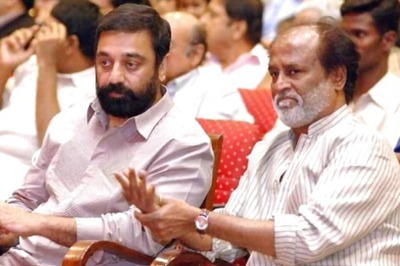
views
Prabal Gurung is living the American dream. He began as a fashion aspirant from Nepal, studied at NIFT, worked with Manish Arora and other designers in New Delhi, and became a colossal success in the American fashion industry within three years. After five years as the design head of Bill Blass, an American womenswear brand, Gurung’s debut collection at the NY Fashion Week, received thunderous applause at the Chelsea showing. Anna Wintour, the editor-in-chief of US Vogue magazine joined prominent fashion editors, retailers and designers to select him as the finalist at the CFDA/Vogue Fashion Fund in December 2010. Shortly after, Gurung’s decadent gowns and smart frocks were worn by A-listers, from the US First Lady Michelle Obama to Hollywood’s Sarah Jessica Parker and Diane Kruger.
When the First Lady wore his red boatneck gown to the White House Correspondents’ Dinner in May 2010, he had officially arrived. Since then, both world media and the fashion industry, have been suitably intrigued by the Singaporean born, Nepali designer.
New Delhi to New York
Gurung’s love for fashion began as early as a “not-so-academic” student at St Xavier’s school in Kathmandu. ‘‘While my friends played football, I sketched. I was ridiculed. But I didn’t care,’’ recalls the designer, who prefers to keep his age a secret. He was a boy who took his pen and sketchboard everywhere. Thanks to his supportive family who was ‘‘sensible enough to understand (my) dream and forte,’’ he enrolled at NIFT, New Delhi, and worked with Manish Arora, followed by brief stints at several fashion houses. Did Arora help shape his aesthetics? Gurung quietly denies this but admits to his admiration for the former artistic director at Paco Rabanne.
‘‘I love him and learned a lot. But his design aesthetic is different. I learned to step out of boundaries and challenge them,’’ says the designer who also adores Abu Jani and Sandeep Khosla, “especially their costumes in Umrao Jaan (2006).” And he clearly didn’t forget what he learned from Arora. Despite his sky rocketing success in India, he got himself into styling projects in Melbourne and London for two years to chase his big goal. In 1999, Gurung moved to New York City, after watching an episode on The Oprah Winfrey Show, about living one’s dream. He studied at Parsons School of Design, which claims alumni like Tom Ford, Marc Jacobs, Donna Karan and Alexander Wang. He also won the Best Designer award at the Fusion Fashion show, an inter-collegiate competition at Parsons, juried by the likes of Cynthia Rowley. He then became part of her design team for two years. Gurung’s career then came come full circle, when Winfrey wore his red taffeta gown on the cover of O magazine.
Tricks of the trade
If competition in the American fashion industry is known to be cutthroat, for Gurung, it’s exciting. ‘‘I’m competitive, and it’s amazing to be in that space. Fashion is art, but it is also a market. I have learned to walk the fine line between art and commerce as I’m a businessman responsible for so many people who work for me,’’ says the designer who won the CFDA Swarovski Award for Womenswear (the fashion Oscars) last June. How did he make the cut in the West? ‘‘By meticulous planning, working with different magazines, preparation, opportunity and patience,’’ offers Gurung, who collaborated with J Crew last May. He has issues when people call him an overnight success.
‘‘Mine was years and years of hardwork,’’ he says, adding that he is in the fashion industry for the long haul. As he shares his office compound at Garment District with friends like Waris Ahluwalia and Biphu Mohapatra, Gurung is aware of the competition. ‘‘I don’t live in a vacuum. I appreciate my fellow designers’ work,’’ he says. And he also happens to be a multitasker, having collaborated with Sally Hansen to create nail wraps with purple-hued prints based on his own Spring Summer 2012 collection and having teamed with pop star M.I.A’s protege, Rye Rye, to dress the singer in his Resort 2011 collection for her music video, New Thing.
Head on shoulders
Has his style changed since the beginning? ‘‘I travel the world and my outlook towards fashion keeps changing. My cuts have gotten better,’’ acknowledges the designer. While he has become the most recognisable face in the fashion industry now, what with the onslaught of media coverage on Rolling Stone, New York Times and Wall Street Journal, Gurung maintains that fame doesn’t bother him. ‘‘There’s always someone who is better than you. So, I feel immensely grateful for all the attention I’m getting. Fame is karmic. And the way I was brought up, it doesn’t bring any sort of stress. I learned the value of integrity and being modest from my mother,’’ says Gurung, who meditates on Skype with his mum every now and then. While he is humble about his success, he has no qualms about dealing with the prying eyes of the critics. New York Times fashion critic (Cathy Horyn), wrote about his Fall 2012 collection, ‘‘Gurung has a lot of talent up his sleeve. But which one? The caped sleeve? The one in fur? Neoprene? He has a similar problem this season with textures and prints. And he styles up his feline prettiness to being within a whisker of a Givenchy show. He ought to give himself the challenge of working with less.’’ To which, the nonchalant designer, responds, ‘‘I really don’t mind. I look at what people have to say about my work. I really do. But it doesn’t make me happy or sad. I read reviews about my collection but it’s like reading any news about an upcoming music video. I don’t expect anything before I read it. I’m aware of what is happenning around me.’’
Recalling India
Gurung’s idea of inspiration is romantic, as he explains, ‘‘Different cultures and people who are aware of themselves, inspire me.’’ But his collection on the runway is less than corny. While his Fall 2012 collection reflected his journey as a designer from ‘‘hell to heaven’’ courtesy dresses with sheer panels, followed by constructed sweatshirts, black dresses injected with panels of neoprene prints and a gown of gold lamé with cut-outs at the sides, his Indian connection surfaced soon enough. Gurung’s Pre-Fall collection this year, featured flared skirts, cashmere jacquard knit dresses and straight-leg pantsuits in earthy and jewel tones, that was inspired by the ‘‘muddy ruins’’ of India.
For his latest Resort 2013 collection, he saw beauty in the sculptural decay of the garbage strewn on Indian streets, and translated that into his designs (peplum tops paired with a slim skirts in digitally enhanced tropical prints) with the help of Canadian sculptor, Aaron Moran. Gurung visits cities like Mumbai once a year, and admits that the country has a huge impact on him. ‘‘India has been an integral part of me as a person and as a designer. The cultures, the textures, aromas and the sounds are profound. I always feel indebted to this country because I started my journey here. Whether it’s the colour, cuts or draping, there is drama. Even normal workers’ saris, colours and combinations are inspiring. And, Bollywood, allows you to dream,’’ reminisces Gurung. While the Indian fashion industry is bursting with new talent like Masaba Gupta and Atsu Sekhose, Gurung admits that the fashion scene in the country is rapidly growing. ‘‘It is becoming exciting. Indian craftsmanship and artisans are appreciated across the world. In terms of fashion, I think we are almost getting there,’’ he affirms. And what about the Indian woman’s fashion sensibilities? He thinks, they are evolving. ‘‘Indian women are a perfect blend of tradition and fashion. They are sensual, have the curves, wear saris and jewellery with equal ease as a dress or a gown,’’ rejoices Gurung.




















Comments
0 comment